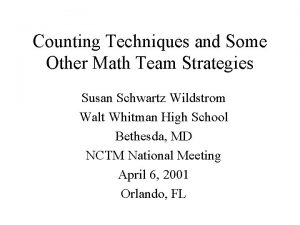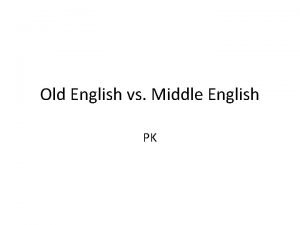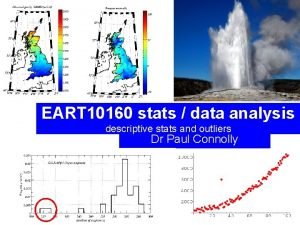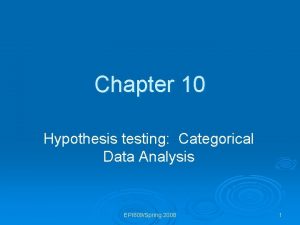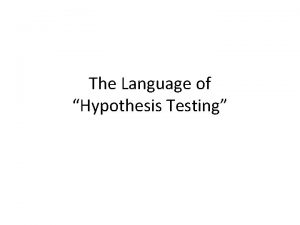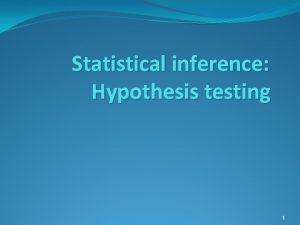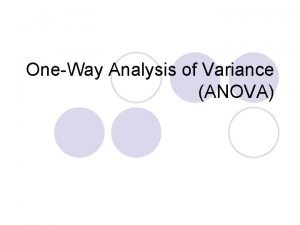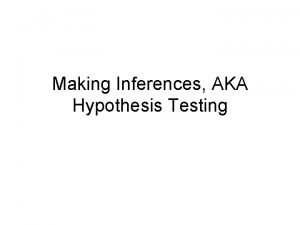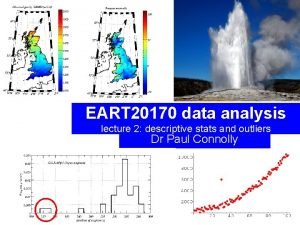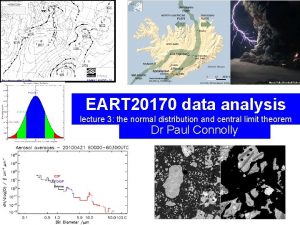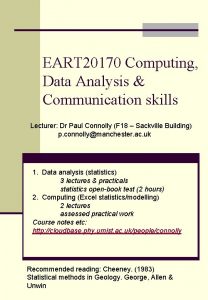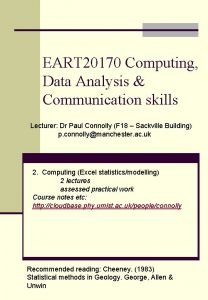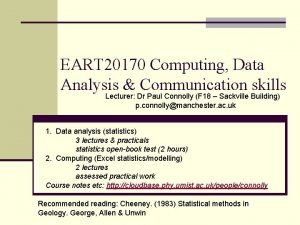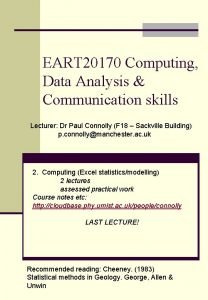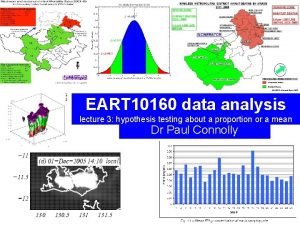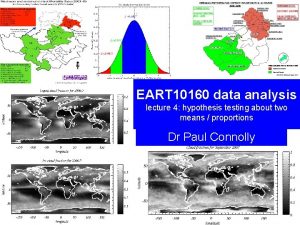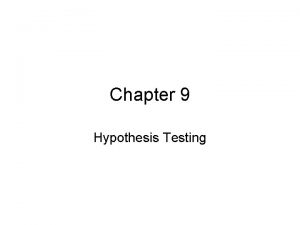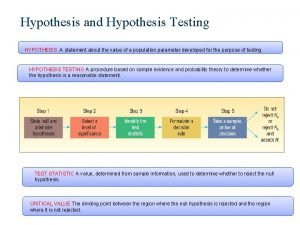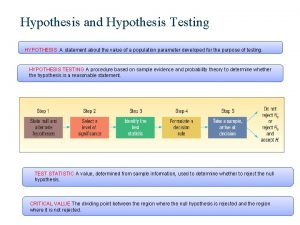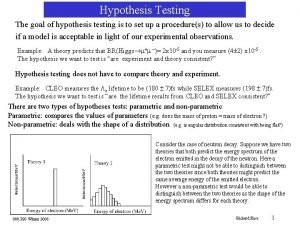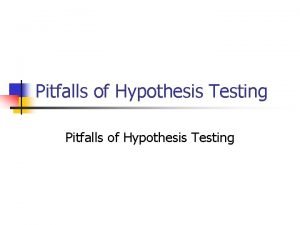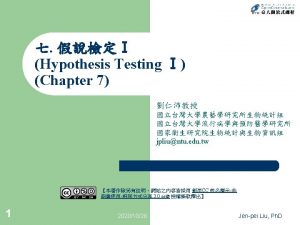EART 20170 data analysis lecture 6 hypothesis testing




















- Slides: 20

EART 20170 data analysis lecture 6: hypothesis testing about two means / proportions Dr Paul Connolly

Why does this kind of hypothesis testing work? (I) • If you take a random sample, size n 1, from a population of which a proportion p 1 answer `yes’ to a question to calculate p 1, then repeat the process for sample n 2, to calculate p 2. you will find that p 1 and p 2. are in general not equal. Statisticians have found, if this process is repeated many times, the statistic, z: p 1 =sample proportion 1 saying either yes or no (depends on convention). p 2 =sample proportion 2 saying either yes or no (depends on convention). p=total proportion saying either yes or no from both samples q=sample proportion saying the opposite to p from both samples • will be: – Distributed according to a standard normal distribution (if the data are drawn from the same population). • Therefore, if we calculate a value of z from our data that is large, we can say it is unusual.

Example: proportions (consumer opinions)

Why does this kind of hypothesis testing work? (II) • Statisticians have found that if you take two independent random samples, size n 1, n 2, from a population with mean m and calculate • it will be: – Distributed according to a Student t distribution if they are from the same distribution. • Therefore, if we calculate a value that has a large value of t, we can say it is unusual.

Example: population mean (differences between two groups)

One-tailed and two-tailed tests • Usually when testing hypotheses using two samples we can have either one or two-tailed tests. • Two tailed test is if we are testing if something is significantly different to something else (e. g. as we did last week) – E. g. the data in sample 1 have a mean that is significantly different (higher or lower) than the data in sample 2. – The mortality rate downwind of incinerators is significantly different (higher or lower) than the rate upwind. • One-tailed test is if we are testing if something is significantly larger or smaller than something else. – E. g. the mortality rate downwind of incinerators is significantly higher than the mortality rate upwind of incinerators. • Important as it affects the probability you put into the `norminv’, (or `tinv’) functions in Excel or MATLAB.

One tailed test Test whether one sample mean is significantly smaller or larger (symmetric so doesn’t matter) than another sample mean at the 5% significance level Area in tail is 0. 05, so significance level is 0. 05. Critical region Critical value (read off on x-axis – or use output of norminv, or tinv)

Two-tailed test Test whether a sample mean is significantly different than another sample mean at the 10% significance level Area in each tail is 0. 05, so area of both is 0. 10. Critical region Critical value (read off on x-axis – or use output of norminv, or tinv)

IMPORTANT: Reiterated from last week! • Those using Excel or MATLAB: – E. g. calculate the critical value of z for a 1 tailed 5% significance level: – norminv gives the distance away from the mean for the input probability so norminv(0. 05, 0, 1) – E. g. calculate the critical value of z for a 2 tailed 5% significance level: – norminv gives the distance away from the mean for the input probability, there are two lots of 0. 025 either side so norminv(0. 025, 0, 1) • Those using Excel (t-distribution) – E. g. calculate the critical value of t for a 1 tailed 5% significance level: – For Excel: tinv gives the distance away from the mean for a two tailed input probability so multiply the probability by two: tinv(0. 05*2, N); • Those using MATLAB (t-distribution) – E. g. calculate the critical value of t for a 1 tailed 5% significance level: – For MATLAB: tinv gives the distance away from the mean for a onetailed input probability so don’t divide probability by two: tinv(0. 05, N); ignore sign

Example of one and two-tailed test • Test whether a sample mean (of size 10) is significantly larger than the sample mean of size 20 at the 0. 01 level of significance (10+20 -2 degrees of freedom) – Excel: tinv(0. 01*2, 28) – MATLAB: tinv(0. 01, 28) [ignore sign] • Test whether a sample proportion (of size 20) is significantly different from a sample (of size 10) proportion at the 0. 05 level of significance – Excel: norminv(0. 05/2, 0, 1) – MATLAB: norminv(0. 05/2, 0, 1) (and ignore the sign!)

This weeks practical: (cloud fraction data from satellite) One month of data from the MODIS sensor (NASA)

This weeks practical • Is most of the planet covered by clouds? – What do you think? – We could try and test the hypothesis that students think it is greater than 50 : 50 • Are most clouds made from liquid or ice? • Is it more cloudy during an El-Nino year than a non El-Nino year? – What is El-Nino?

The Walker Circulation: Climate and Energy EART 30362 lecture 8 B-9

Changes to the Walker Circulation During El Nino: Reduced upper level wind speeds, weakened Walker Circulation Reduced surface wind speeds: weakened Walker circulation Higher sea surface height in E Pacific Reduced or zero thermocline gradient across Pacific Deeper layer of warm water, deeper thermocline in eastern Pacific

Changes to the Walker Circulation during La Niña: Increased upper level wind speeds, enhanced Walker Circulation Increased surface wind speeds: enhanced Walker circulation Lower sea surface height in E Pacific Enhanced thermocline gradient across Pacific Nutrient rich water close to surface Shallow layer of warm water, shallow thermocline in eastern Pacific

• Liquid clouds are predominant on west coast of Chile, US and South Africa. H H H – In regions of high pressure – Learn about why high pressure results in little high cloud, but low cloud in Meteorology course (EART 30551). • Ice clouds predominant over the Indonesian tropical warm pool

The practical this week • The aim of the practical is to give practice with dealing with a large dataset and using it to test interesting? Hypotheses. • We are in the Simon computing cluster 1012.


Coventry Last week we asked whether mortality rate downwind was significantly higher than the population. What if we just wanted to ask whether the two groups of people are different? Doesn’t prove that the incinerator makes them different, but that they are different (or not!)

Definition (recap) • Hypothesis: A testable statement on the basis of limited evidence as a starting point for further investigation. • Null hypothesis: A type of hypothesis used in statistics that proposes that no statistical significance exists in a set of given observations. • Alternate hypothesis: the opposite to the null hypothesis
 Webgl google earth
Webgl google earth Nimmo technique
Nimmo technique Meteo eart
Meteo eart Eart
Eart Googol eart
Googol eart Genesis 11 1-9 nkjv
Genesis 11 1-9 nkjv Eart
Eart Thy thou thee old english
Thy thou thee old english How to plot
How to plot H0no
H0no Data flow testing strategies in software testing
Data flow testing strategies in software testing 01:640:244 lecture notes - lecture 15: plat, idah, farad
01:640:244 lecture notes - lecture 15: plat, idah, farad Exploratory data analysis lecture notes
Exploratory data analysis lecture notes Hypothesis testing mean
Hypothesis testing mean Alternative hypothesis
Alternative hypothesis Alternativehypothesis
Alternativehypothesis Protoplanet hypothesis weakness
Protoplanet hypothesis weakness The language of hypothesis testing
The language of hypothesis testing P-value interpretation
P-value interpretation One-way anova hypothesis testing
One-way anova hypothesis testing Hypothesis testing assignment
Hypothesis testing assignment




